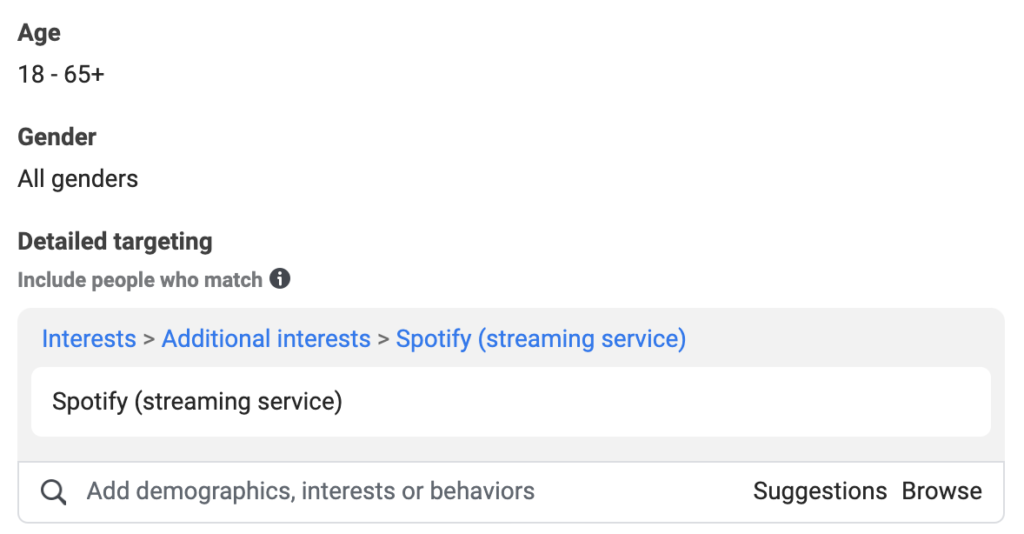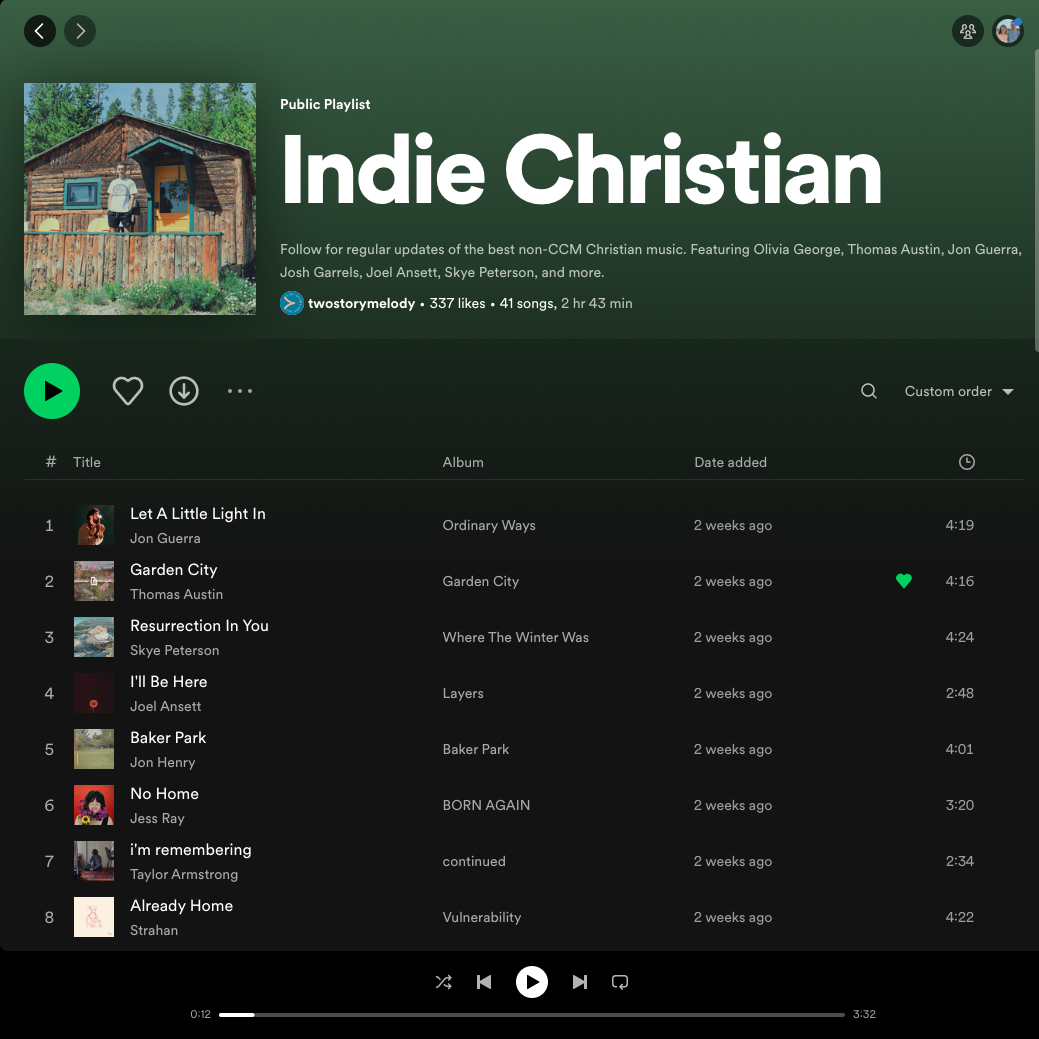So I’m in the midst of a fun little experiment…
I’m building a playlist network.
In this post, I’d like to tell you a little bit more about what I’m doing with the playlist network and how it’s going – because it’s kind of my pet project right now, and because I feel like I owe you something tactical.
Here’s the general idea:
Let’s say, hypothetically, that I’m friends with four or five artists who are making music that could be loosely be qualified as folk. And let’s say, hypothetically, that I just so happen to curate 10 or 12 popular Spotify playlists in the folk genre – lists with thousands of followers and names like “Folk Music for Rainy Fall Days” or “Coffeeshop Folk Music.”
You get the picture. Every time one of my friends releases a new song, I could add it to my playlists, and boom: My little posse gets an easy source of genre-targeted streams.
Why not do this, right?
Well, four reasons. First, the terms of Spotify’s user guidelines have always given me a bit of pause; the language forbids accepting compensation for “influence over the content of a playlist.” And while I would definitely not accept payment for a playlist placement, specifically, I also would definitely want to add my own consulting and ads clients to my own lists. I’m not a lawyer, so I don’t know if I’d win a contract dispute over this (or even what a contract dispute is, to be honest), but morally it just feels a little gray to me.
Oh and the other three reasons are 1) money 2) time and 3) I’m lazy.
Right. Anyway, I probably should’ve done this years ago, but I’ve finally decided to do it in the back half of 2023, and here’s what it actually looks like.
1. I made a list of 10 potential playlist name
Long-term, maybe I’ll make hundreds of playlists, but for now, I’ve got 10 that I’m going to try out:
- Songs for rainy fall days
- Indie Christian
- Indie Roadtrip
- Study music (non-instrumental)
- Driving at night
- Coffeeshop Christian
- wrestling with God
- In my feelings again
- Indie pop or something
- Fall Acoustic
Is there any rhyme or reason to this list? Kind of.
I’m loosely targeting similar genres – stuff that’s indie, Christian, folk, and acoustic – because a lot of my friends make music in this range. And I’ve tried to pick a few commonly-searched terms for 1) moods, 2) activities, and 3) genres.
But honestly, I’m mostly just shooting in the dark. In likelihood, some of these playlist titles will resonate with wide audiences, and some will fail miserably. We’ll see.
2. I’m building these playlists strategically.
Well, I hope that I am. Here’s what I’m trying:
Each list is built so that 80% of the songs are popular and 20% are by my (less popular but still good) friends. The idea is that, when an average listener finds one of these playlists, they’ll be more likely to follow it because they’ll recognize some of the names and songs on it.
More specifically, the first song on each playlist is by an established artist. The second song, almost always, is not.
So far, this seems to be working.
I’m keeping the lists fairly small. By that I mean that I’m “only” including about 40 or 50 tracks on each list. I know most popular playlists include hundreds of songs, so maybe this is a mistake – but I want each playlist to be an honest attempt at creating a soundtrack, not a mass-placement money-grab masquerading as curation.
I’m cynical, I know.
I’m specifically asking users to follow these playlists in the descriptions. I think people are more likely to take an action when you specifically ask for it, so I’m following that bit of marketing wisdom here. And I’m incentivizing the follow by promising (also in the description) that I’ll regularly update each playlist, so that users have a reason to keep coming back.
But how are users actually supposed to find these playlists in the first place, you ask? Simple…
3. I’m running Meta ads to the playlists.
If you’re familiar with the world of playlists, 1) I pity you, and 2) you know that paid ads are the primary way that people build popular lists.
Now, the long-term hope is that you can get a playlist to rank in Spotify’s search results, which will provide a (potentially very large) flow of non-paid traffic. But most often, playlist growth starts with paid ads before a list earns Spotify’s favor.
As for the ads themselves, I’m trying a few different things:
1) A video flipping through album art for some of the most popular songs on the playlist.
2) A video with artist names scrolling up the screen (think credits at the end of a movie).
3) Literally just a mobile screenshot of the playlist. (I thought this was dumb, but I heard some people saying it worked really well… and it kind of does.)
Each version has a couple of variants, but that’s the gist. So far, the name scrolling versions are performing best, but we’re still pretty early, so I don’t think the differences are too significant. Again, we’ll see.
In terms of targeting, I’ve kept things ridiculously broad to start:

Yeah, literally just Spotify as an interest without any sort of age paring, sent out to Tier 1 and Tier 2 countries.
Stupid? Maybe. Probably.
I’m basically daring Facebook to waste my money – but so far, they’ve done a decent job. The results after nearly a week aren’t eye-popping, but they’re trending the right way over time. I’m at about $0.13 per click and heading down, which for an artist-specific campaign would be quite good.
And five days in, the clicks are turning into a few followers.


That first image is a playlist that’s been live for four days and so far has notched 171 likes. The second image is the number of streams the playlist has generated for the song in its second slot, also over a period of four days. (For what it’s worth, the song in the fifth slot has gotten 29 streams, also over a period of four days.)
It’s small potatoes at the moment, but if the growth rate can increase just a bit, if the followers and streams compound over time, and if there are 10+ other playlists bringing in similar numbers, too, you can see how it could get significant quickly,
And maybe most importantly: Growing these playlists will benefit a bunch of my friends rather than just a single artist.
The downside, as it always is with playlists, is that these streams will almost certainly be less engaged than streams directly to a single artist.
Again, it’s a fun little experiment.
Truthfully, I probably should’ve been working on this five years ago. But, following the wisdom of that wonderful Chinese proverb about planting trees, I’ve got a hunch that the second best time is now.
One final note before I wrap this up, which my default mode of self-deprecation demands I provide:
Don’t take any of the above as some sort of direct advice.
By which I mean don’t just copy-paste these tactics into your own marketing spend, because I don’t know yet if this will work and I don’t want you to waste your time and money if it doesn’t.
I’ve built artist-specific playlists before, but I haven’t built a wider network of playlists. And I don’t consider myself an expert on Facebook ads (or on much of anything outside of the game of Nim, really). I just have the good fortune to be in a position where I can try a bunch of things, see what works, and not have my boss yell at me when my attempts backfire.
Take this for what it is: A tactically-minded post on a fun little experiment. We’ll see where it goes.








